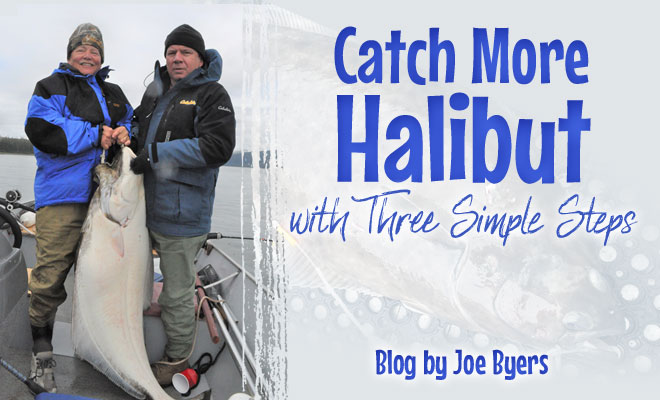 Halibut Fishing Tips: Catch More Halibut with Three Simple Steps
Halibut Fishing Tips: Catch More Halibut with Three Simple Steps
Blog & Photos by Joe Byers
Since Alaskan anglers are limited to a single rod, experimentation with various rigs and baits is difficult. However, British Columbia has no rod limit and John Beath experiments with his Smart Squid lures extensively there for halibut.
Halibut fishing is pleasure or pain. When fish are biting, little can match the excitement of hooking up since you never know what’s on the other end–dinner or a goliath. Such was the case in mid-July while fishing at Island Point Lodge in their “Fish-On-Your-Own” program which landed six of us in two small boats in the Wrangell Narrows just south of Petersburg.
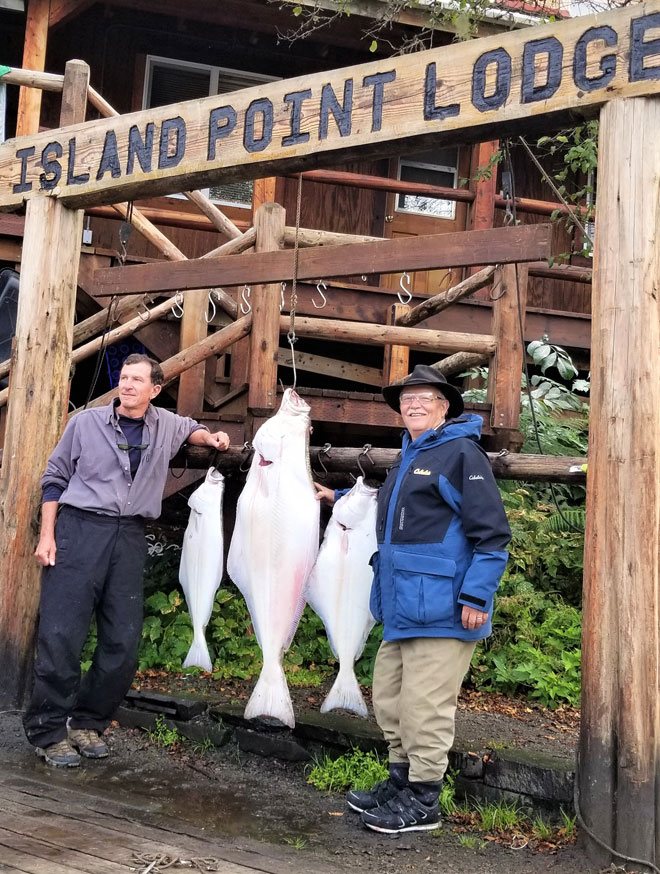
Ed Beachley (left) and the author caught these nice fish in just a couple of hours using John Beath halibut tactics. Beachley’s big halibut weighed 82 pounds.
After interviewing Beath about his halibut fishing tips, I ordered several of his lures and employed them for the first time, a rig that included light and sound. The other anglers used standard spreader bar and weight combinations teamed with a single- or double-hook rig and frozen herring for bait. Since this was the gear recommended by the lodge, my five friends used them, while I played guinea pig.
We anchored in 90 feet of water and the second boat fished nearby as our one-pound weights sunk to the depths. This was our first afternoon of fishing and we had only a three-hour window before dinner. Luckily, action didn’t take long as my rod tip suddenly bent and line peeled of my reel from a powerful run. The battle ensued for about 10 minutes and we got our first fish, about 25 pounds, in the boat. Excitement ruled as four of the six anglers had never seen a halibut before.
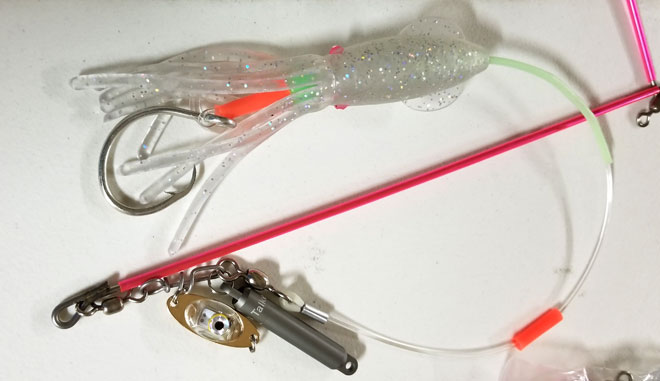
The author’s combination of light, sound, and scent outfished his friends 3-0, despite using the same bait.
Back to the Depths
I had fished this spot five years earlier and believed I was in the right area. Not long afterward, that hunch was affirmed as my rod tip dove deep for a second time. This one seemed a little bigger, and it was gratifying to finally get it in the boat. Suddenly, I realized I had a limit of halibut in just a few minutes. Holy Cow!
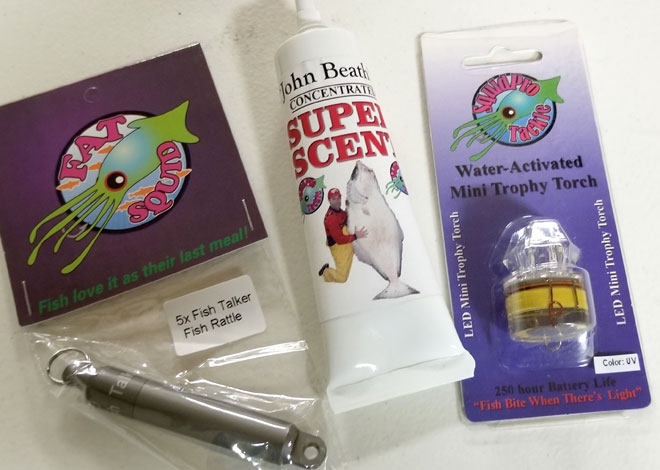
John Beath uses scent, light, and sound to catch more fish. Adding scent makes this three-pronged approach even more effective.
As time toward departure neared, I suggested that my dentist friend, Ed Beachley, use my rig and I optimistically handed it to him. In less than 10 minutes, Beachley was standing and fighting a really big fish. Whereas my fish grudgingly came steadily toward the surface, this big guy wasn’t budging.
After pumping and fighting steadily, the fish saw the small boat and made another line-screaming run. As the fish tired and Beachley horsed it to the surface, I launched a harpoon, but to our horror, the tip pulled loose from the line. Luckily, my friends in the other boat were not far away and they passed us their harpoon which worked properly.
After pulling this beast into the boat, Dr. Beachley no doubt was astounded at the largest “extraction” he’d ever made. Back as the lodge, we posed for pictures and the official measurement: 82 pounds.
Six Rods, One Worked
With three nice fish in such a short time, I was certainly impressed, especially since my rig caught 1.5 limits while the other five caught zero. Beath operates the Squidlures.com website and experiments extensively with factors that catch more fish. Clearly, his halibut fishing tips and ideas worked for me.
Beath likes to find humps and bumps on the ocean floor and fish on the downslope of them, believing that halibut swim up and down searching for food. Once he finds a good location, he marks the spot on his phone using the GPS feature so that he can return to that exact place with or without cellular service.
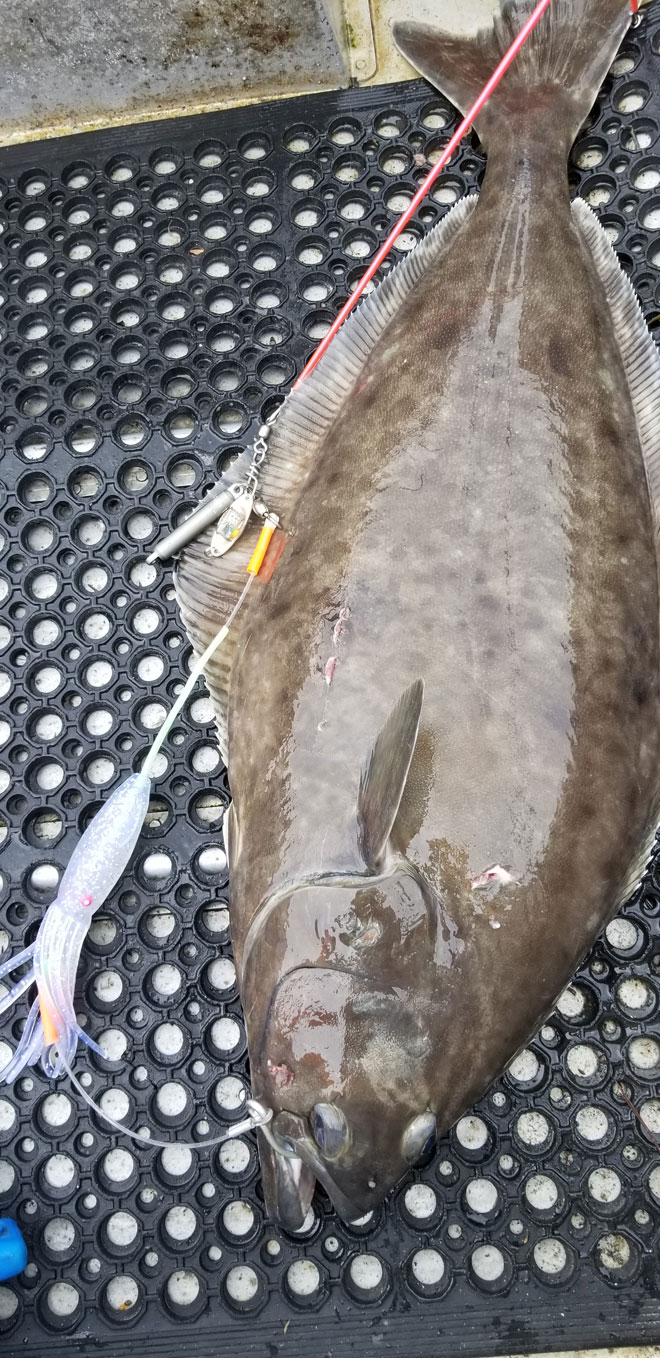
A 20-pound halibut and Beath’s rig.
Use Noise
Sound is one of the least thought-of factors, yet Beath believes it’s a powerful attractant. “I add noise makers to my baits which helps improve the bite,” he says. “If you have a spreader bar, use an old salmon spoon that will create noise. Noise will travel 11 times longer and five times as loud underwater and halibut have a lateral line that enables them to feel without touching. Using a noise maker will attract them from a great distance.”
One summer, Beath experimented in British Columbia where he used sound on one rod and silent gear on the other. At the end of the summer, the rod with sound caught four times as many fish.
Beath’s theory was confirmed by a commercial fishing captain who gave us fresh squid for bait. “We always add fishing lines to our anchor,” he said as we paused alongside his craft. “Whenever the anchor hits the bottom, fish come to investigate the sound, and we take advantage of it.”
Bottoms Up
Most halibut anglers fish on the bottom, but Beath believes there’s a better way. “I suggest keeping your bait 4-6 feet up from the bottom because if the bait is above the bottom, you get a more aggressive and fast bite,” he suggests. “With circle or J-hook rigs, bang the bottom with your weight and reel up four-to-six feet, jig it, and let it back down.” No doubt, moving the bait puts more scent in the water and a halibut can smell a food source in water from a mile away, according to Beath.
A side benefit of fishing above the bottom is the reduction in bites from sculpins, crabs, and other bottom feeders. One member of our party caught eight “ugly fish” including one that was nearly 20 inches long. He consistently allowed his bait to lay on the bottom and had to deal with nuisance fish.
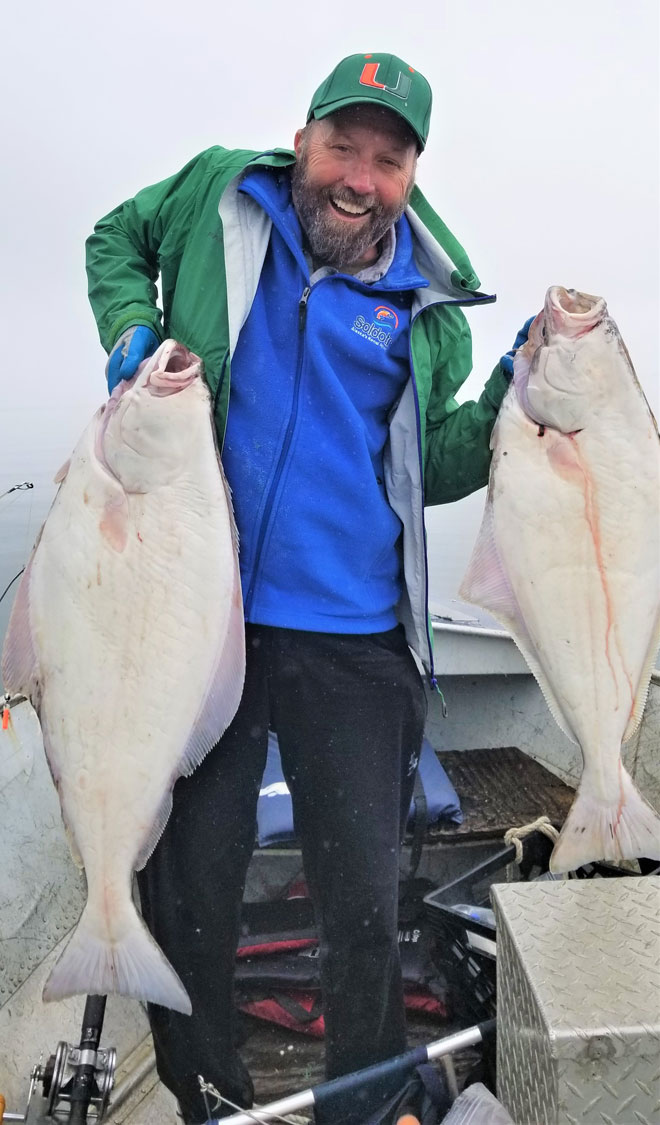
Don Wilson grimaces under the weight of his first two halibut ever. Both were caught using Fat Squid lures, scent, and frozen herring.
Light Attracts
Light is another Beath innovation. “I like to add underwater light,” he says. “In nature, squid luminescence will get fish to bite.” Beath markets a light device that turns on underwater and off when not submerged which saves battery life and there’s no need to work with an on-off switch.
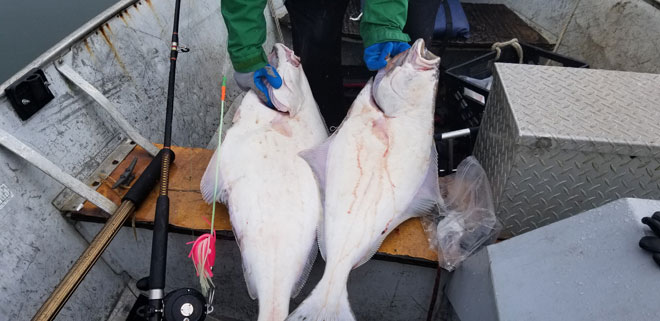
Shown is Wilson’s lure and the results.
Scents
Scents also attract fish and we used a mixture of oil and paste that seemed to increase the bite. On our last morning we fished a little over three hours, had six bites, lost two, and landed two. For halibut fishing that’s decent action. Beath’s scent paste adheres well to plastic lures and you can put it in the mouth of a herring to increase attraction.
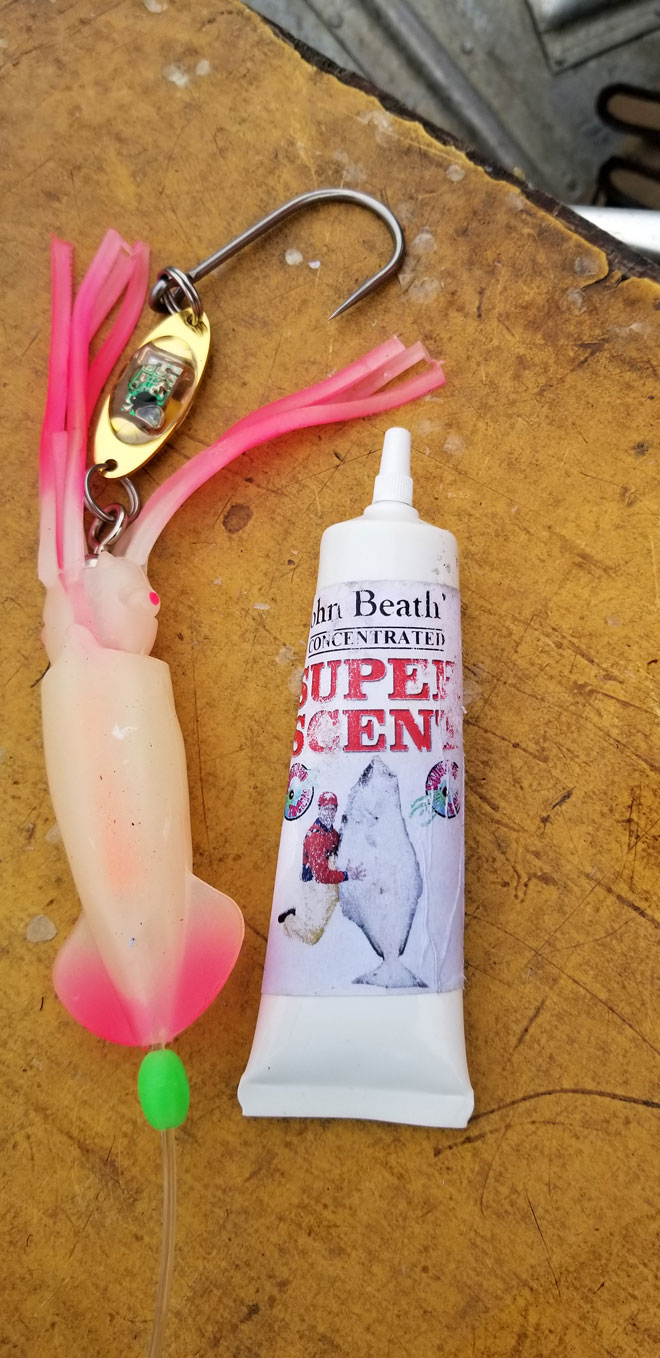
Beath’s scent adheres to plastic lures very well keeping the scent trail working long after application.
Maximize Your Chances
Any of the above halibut fishing tips can help improve your angling success; however, these strategies work best when combined. Use herring, squid, or whatever, add light, sound, and scent. Most importantly, keep that bait just above the bottom. With both eyes on the top of its head, Mr. Halibut can only see what’s above him.
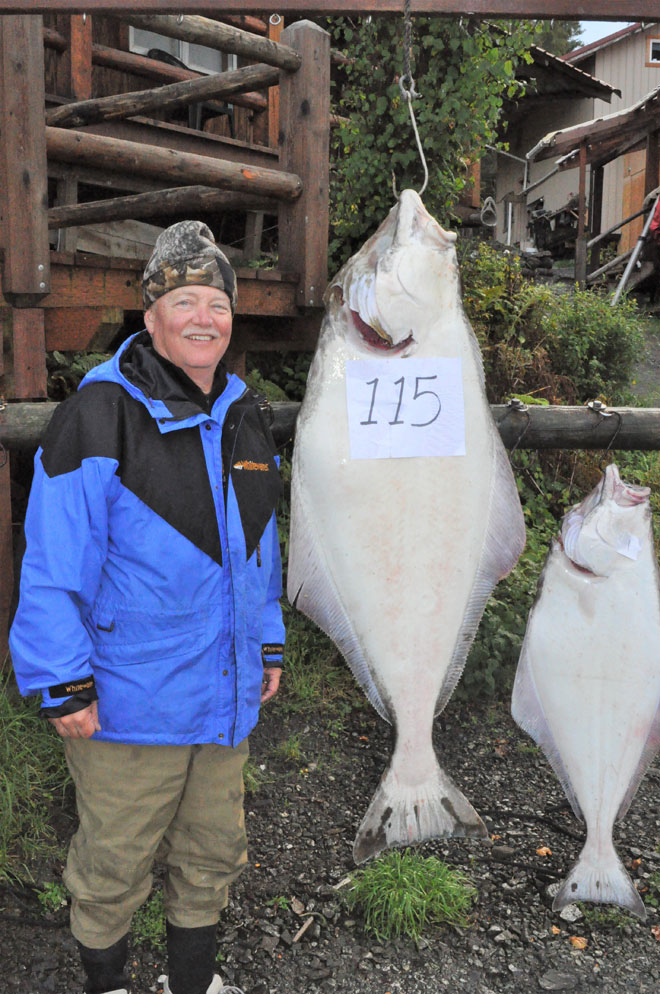
The author’s largest halibut, 115 pounds, was caught on a Fat Squid and spreader bar combination.
Joe Byers has been communicating a love of the outdoors through text and photography for 40 years. He has fished the four corners of Alaska and hunted much of the world. A retired educator, sharing the excitement, adventure, and passion for the outdoors is homework he loves.
Author’s Note: John Beath’s website has lots of gear and fishing ideas. Check it out at squidlures.com. Island Point Lodge in Petersburg is an excellent DIY facility for any halibut and salmon trip: islandpointlodge.com.
